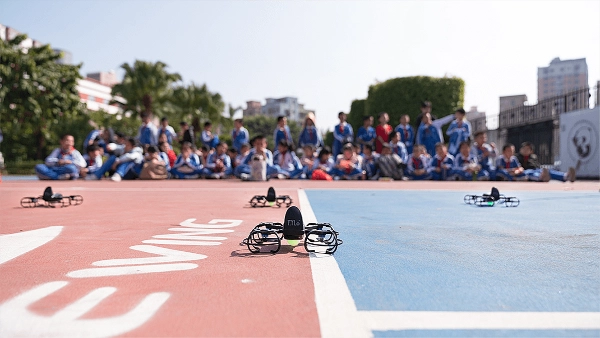Drones for Educational Use: Programming Teaching
Using drones in teaching offers an innovative and engaging approach to learning, especially in STEM (science, technology, engineering and mathematics) education. Within these disciplines, programming is one of the key areas where drones can have a significant impact. By integrating drones into programming courses, educators can provide students with hands-on experience to enhance their understanding of coding concepts and logical thinking. In this blog post, Highgreat, a high performance programmable drones for schools manufacturer, will share the importance of drones for educational use in teaching programming.
Why Use Educational Drones for Programming Teaching?
Traditional programming education often relies on coding exercises that are confined to a computer screen. While these exercises are beneficial, they may not always captivate students' interest, especially younger learners. Drones introduce a tangible and dynamic element to programming, making coding lessons more interactive and exciting. Here are some key reasons why drones are valuable for programming education:
1. Hands-on Learning
Programming with drones allows students to see immediate, real-world applications of their code. By writing and executing programs, students can control drone movements, perform automated tasks, and even create autonomous flight patterns. This real-time feedback reinforces coding logic and problem-solving skills.
2. Engagement and Motivation
Drones make learning more fun and engaging. Rather than simply typing commands on a screen, students can witness their codes translating into physical movements. This engagement encourages creativity and deeper exploration of programming concepts.
3. Real-World Applications
Teaching programming with drones helps students understand how coding is used in industries such as logistics, surveillance, and scientific research. It also introduces them to emerging technologies like artificial intelligence (AI) and automation, preparing them for future careers.
4. Encourages Teamwork and Collaboration
Drones can be used for group projects, where students collaborate to program drones for specific missions. This teamwork fosters communication, leadership, and problem-solving skills, which are essential for success in both education and professional life.

How to Integrate Educational Drones into Programming Lessons?
Successfully incorporating drones into programming education requires careful planning. Here are some key steps to effectively use drones in the classroom:
1. Choose the Right Drones
When selecting drones for educational purposes, it is important to consider factors such as ease of use, safety, and programming compatibility. Some beginner-friendly drones that support coding include:
- DJI Tello EDU - Supports Python, Scratch, and Swift programming.
- Parrot Mambo - Compatible with block-based coding and Python.
- Ryze Tello - Integrates with Scratch and Python.
These drones allow students to write code to control flight movements, automate tasks, and develop problem-solving skills.
2. Select an Appropriate Programming Language
The programming language chosen should match the students' skill levels. For beginners, block-based coding languages like Scratch are ideal, while more advanced learners can use Python or JavaScript to develop complex drone functions.
3. Develop a Curriculum
To maximize the educational benefits, educators should design a structured curriculum that integrates drone programming into lesson plans. A typical curriculum might include:
- Basic Programming Concepts - Introduction to loops, conditionals, and variables using block-based coding.
- Drone Flight Basics - Understanding drone mechanics and basic flight commands.
- Automated Flight Missions - Programming drones to complete obstacle courses or deliver payloads.
- Advanced Coding Challenges - Implementing AI, computer vision, or data collection techniques.
4. Encourage Problem-Solving Activities
Drones provide an excellent platform for problem-solving exercises. Educators can design challenges such as navigating a maze, simulating package delivery, or coordinating multiple drones to work together. These tasks develop students' critical thinking skills and encourage creativity.
5. Ensure Safety and Regulations Compliance
Safety should always be a priority when using drones in educational settings. Teachers must educate students on drone regulations, indoor vs. outdoor flying, and proper safety procedures. Using drones with protective guards and setting up controlled flying environments can minimize risks.
Success Stories: Schools and Institutions Using Drones for Programming Education
Many schools and educational institutions worldwide have successfully integrated drones into their programming courses. For example:
- STEM Schools in the U.S.: Many STEM-focused schools have adopted drone programming as part of their curriculum, using platforms like Scratch and Python to teach coding through hands-on drone activities.
- Universities and Research Labs: Higher education institutions use drones for research projects, robotics courses, and AI development, providing students with advanced technical skills.
- Online Coding Bootcamps: Various online platforms offer courses that teach drone programming, allowing students to learn remotely while controlling drones in real-world environments.
Conclusion
Drones for educational use, particularly in programming teaching, offer a revolutionary approach to learning. By bringing coding concepts to life, drones enhance engagement, improve problem-solving skills, and prepare students for the future of technology-driven industries. With proper planning, safety measures, and curriculum design, drones can become an invaluable tool in modern classrooms, inspiring the next generation of innovators and programmers. Educators and institutions should embrace this technology to make learning more interactive, dynamic, and impactful.

 Telephone No.Email
Telephone No.EmailMailbox number:marketing@hg-fly.com



